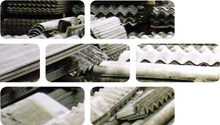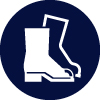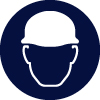
Asbestos Containing Materials Hazardous 17 06 05
Asbestos containing materials (ACMs) are a broad range of products containing asbestos that are controlled substances. They are made from a mixture of fibrous asbestos and other materials that is compressed and dried into a range of construction products, including sheets, pipes, boards, tiles, mats, insulation, lagging, gaskets, flexible couplings, rope, fuses, mastics, beading, filler, putty, some bituminous materials and some equipment or appliances. Asbestos containing materials were made in various sizes and designs depending on the desired performance and intended use. They are hazardous materials and need appropriate and specialist treatment and handling.
Usage & Probable Locations
Asbestos containing materials have been used to prevent fire or heat transmitting between materials and to sustain building structural integrity during fire. They can be found in domestic, commercial and industrial buildings fixed to or within ceilings, walls, cavities, roofs, floors, panel systems, lift shafts, service routes, piping, equipment, appliances, brake linings, mastics, joints of products and some architectural features.
Personal Protective Equipment
PPE requirements indicated are for guidance purposes only. DRIDS has identified the PPE that is mandatory on all demolition projects and ones that may be required subject to site specific Risk Assessment & Method Statement (RAMS). Hover over the icon to determine the types of PPE required for the removal of this material.
Removal, Segregation & Storage
Asbestos containing materials destined for landfill should only be removed by approved, specialist contractors. They are to be carefully deconstructed, segregated and stored safely according to strict guidelines and protocols. They should be removed from site in accordance with HSE legislation with the appropriate RPE/PPE.
Tools
Fixtures, Fittings & Connections
Asbestos containing materials are commonly fixed in place with nails, screws, bolts, plugs, nuts and bolts, straps, mortar, screed, putty, mastic, glues, adhesives or other binding agent. Some asbestos containing materials required no fixings, they were placed within cavities, between other products or manufactured within products including panel systems, doors and floors.
Health & Safety
Subject to task-specific Risk Assessment & Method Statement (RAMS). Only remove asbestos containing materials if appropriately trained, or use specialist contractors. Wear gloves and respiratory protective equipment when handling asbestos cement products to prevent inhalation, irritation, cuts and abrasion. Use eye protection when using hand tools. Limit hand, arm and whole body vibration when using impact tools. Use appropriate access and protective equipment determined by RAMS.
Further reading
- HSE List of Products Maybe Containing Asbestos
- Google Images of Asbestos Containing Materials
- USA List of ACMs
- HSE Asbestos Essentials
- HSE What to do if you uncover asbestos
- HSE Asbestos Resources and Reading
- NFDC Guidance
- Control of Asbestos
- Asbestos FAQ
- Removing Asbestos Cement Sheets
- NetRegs - Managing your hazardous/special wastes










